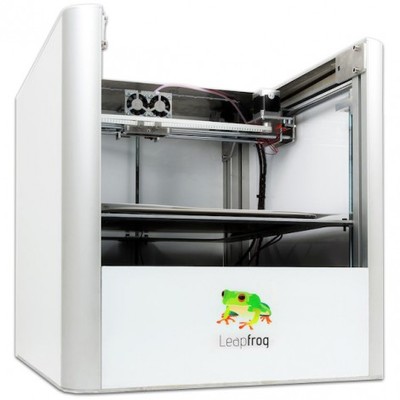The quality of a 3D print is often measured by the layer size. That represents the size of the incremental layers put down by the extruder (or other mechanism) of the 3D printer. The smaller the layer, the finer and smoother the surface finish becomes.
The first personal 3D printers that emerged several years ago typical offered 0.5-0.4mm layers, as their mechanical ability was limited compared to today’s machines. Were layers smaller then, the machines would have taken forever to slowly trace each layer’s pattern.
Current personal 3D printers offer 0.25-0.20mm layers and more advanced machines can even hit 0.125-0.10mm layers. But now Leapfrog has made this announcement:
After performing several tests, we can announce that the Creatr is now able to print with a minimal layer thickness of 0.05 mm. We will be providing print settings within the next month; these will be updated in Repetier Host Leapfrog automatically.
That’s it – the Creatr has effectively doubled the number of layers that most of their competitors can achieve, resulting in a fantastically smooth finish on printed objects.
One question we’re wondering about is, can printer owners survive the lengthy print times of micro-layered objects? If you halve the layer size, you double the number of layers and thus double the print time. Four hours becomes eight hours, and so on. We’re hoping manufacturers double the extrusion speed whenever they halve the layer size.
Via Leapfrog



Oops. "Cura". 🙂
Oops. "Cura". 🙂
@Lucastar: apparently in a recent beta Cuda has removed skinning:
http://umforum.ultimaker.com/index.php?/topic/2008-looking-for-beta-testers/page-4#entry14856
I don't know if it's been restored in the last two months…
@Lucastar: apparently in a recent beta Cuda has removed skinning:
http://umforum.ultimaker.com/index.php?/topic/2008-looking-for-beta-testers/page-4#entry14856
I don't know if it's been restored in the last two months…
The Buildabot 3d printer from http://www.York3dPrinters.com has been able to print 0.05 for about a year… but agree.. its almost pointless unless you are making shapes with very gentle slopes… 0.1 is more than fine for everyday use…
@ John: There is a 'skin' function in some software that allows you to print the outer wall with thinner layers than the inside – means you can fill the model interior quickly, and make a good careful and fine resolution job of the outside. Buildabot 3d printers are supplied with Cura operating software , which supports this function, and will also run on Repetier very simply (which also supports this function)
The Buildabot 3d printer from http://www.York3dPrinters.com has been able to print 0.05 for about a year… but agree.. its almost pointless unless you are making shapes with very gentle slopes… 0.1 is more than fine for everyday use…
@ John: There is a 'skin' function in some software that allows you to print the outer wall with thinner layers than the inside – means you can fill the model interior quickly, and make a good careful and fine resolution job of the outside. Buildabot 3d printers are supplied with Cura operating software , which supports this function, and will also run on Repetier very simply (which also supports this function)
@who & @Donny: Lots of experiments have achieved this before, yes, but this is one of the few major manufacturers to specify this as a certified machine configuration. Yes, more layers requires MUCH more time and probably isn't worth it, depending on what you're printing.
@John: Totally agree. There are so many ways slicing could be improved and that's one of the ways. It's just that no one's done it yet, that we know of.
@who & @Donny: Lots of experiments have achieved this before, yes, but this is one of the few major manufacturers to specify this as a certified machine configuration. Yes, more layers requires MUCH more time and probably isn't worth it, depending on what you're printing.
@John: Totally agree. There are so many ways slicing could be improved and that's one of the ways. It's just that no one's done it yet, that we know of.
Do any 3D printers allow dynamic adjustment of the layer size? It seems to me you don't need to print the entire object's volume at the maximum resolution…
Do any 3D printers allow dynamic adjustment of the layer size? It seems to me you don't need to print the entire object's volume at the maximum resolution…
I agree with the above poster. My machine can print at 0.04mm reliably but when it takes 15 hours v/s 7 hours to print a small model that's 5" high with no real noticeable difference whats the point. I can print at 300ipm and rapid at 1200ipm but it still takes forever. 0.1mm is just fine for 99.9% of things that are over 25mm high.
Donny
I agree with the above poster. My machine can print at 0.04mm reliably but when it takes 15 hours v/s 7 hours to print a small model that's 5" high with no real noticeable difference whats the point. I can print at 300ipm and rapid at 1200ipm but it still takes forever. 0.1mm is just fine for 99.9% of things that are over 25mm high.
Donny
We've been able to print .05 on a bukobot for over a year, and recently successfully tested printing at .02. The fact is though, that printing layes smaller than .1 really doesn't give enough increase in quality to justify the additional time it takes to print (at least with the current FDM technology).
We've been able to print .05 on a bukobot for over a year, and recently successfully tested printing at .02. The fact is though, that printing layes smaller than .1 really doesn't give enough increase in quality to justify the additional time it takes to print (at least with the current FDM technology).